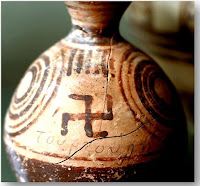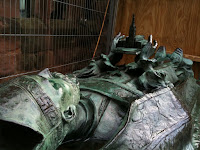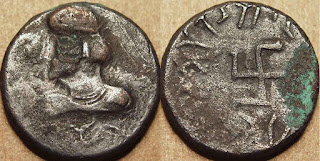The auspicious symbol of the swastika is very commonly
used in Hinduism. It is usually a major part of the decoration for festivals
and special ceremonies like weddings. The word ‘swastika’ is a Sanskrit word
(‘svasktika’) meaning ‘It is’, ‘Well Being’, ‘Good Existence, and ‘Good Luck’.
However, it is also known by different names in different countries - like
‘Wan’ in China, ‘Manji’ in Japan, ‘Fylfot’ in England, ‘Hakenkreuz’ in Germany
and ‘Tetraskelion’ or ‘Tetragammadion’ in Greece.
The clockwise swastika is one of the 108 symbols of the
god Vishnu as well as a symbol of the sun and of the sun god Surya. The anti-clockwise
swastika (called a sauvastika) usually represents the terrifying goddess Kali,
night and magic. However, this form of the swastika is not “evil” and it is the
form most commonly used in Buddhism.
Vedas are possibly the oldest sacred texts and you find
mentions of Swastika in Rig Veda, Atharva Veda and even Yajur Veda. Swastika
has always been with the sanatan dharma. But when you do research on its
journey, you realise how this has been prevalent from ages in different
religion and civilizations. How and why did so many diverse countries and
cultures, across many eras, use the same symbol and apparently with the same
meaning, I do find it intriguing. In West, Swastika is now more associated with
Nazis and Hitler. But use of it can be seen long before that and by different
religion. What was common was the fact that everyone considered it as symbol of
good luck. And it do proves a point - Humanity brings every religion together.
North Pole Star is called Dhruva Nakshatra in Sanskrit
literature. Saptarishi are seven stars of the Big Dipper named after seven
Rishis in our Vedic scriptures. North Pole Star is the center of Kalachakra
around which Saptarshi Mandala revolves around a fixed centre on clockwise
direction. Through the four seasons, the SaptaRishis form a swastika in the
sky. I think this is the first Swastika of this planet earth.
Many a time forts were built in the shape of Swastika as
it was difficult then for enemy to attack all parts. But most interesting
current day military building with Swastika structure is the US Navy SEALS
base.
Here is a list of Swastikas that I found across the globe
while searching internet. I am sure there are lot more, and maybe someday will
get back and search more in-depth.
There is a village in Ontario named Swastika. Many
attempts of Canada govt to change the name failed as villagers did not agree
to. The Fernie Swastikas were a women's hockey team that was formed in 1922 in
Fernie, British Columbia.
|
|
|
Use of Swastika in ancient monuments, reliefs and statues:-
|
Human swastika
motif from a Pictish recumbent grave slab at Meigle Museum Perthshire, 7th
century
|
Approximately 86
kilometers northeast of the city of Beirut in eastern Lebanon stands the
temple complex of Baalbek. This is a swastika relief on Jupiter Temple of
this complex.
|
|
The ceramic
ceremonial bust of the Goddess Hera. Classical period. Paestum,
Italy-Archaeological Museum of Paestum
|
The use of the
swastika as an African symbol is an established tradition that still
flourishes today amongst the Akan or Ashanti people of western Africa. The
swastika is also one of the Akan people's famous Adinkra symbols.
|
|
Ancient Achean
"doll" with human, solar and tetragammadion (swastika) symbols.
Louvre Museum, Paris
|
The numinous
vulva again, inscribed with svastika, on a lead figurine found 23 ft below
the surface at Troy
|
|
Odin
|
Celtic Priest
Stone Monument Ireland 4th century AD
|
|
Istanbul Hayia
Sophia Gates
|
Irminsul - to
the northern Teutonic people, it was a representation of Yggdrasill, the
World Tree. The figure on the left represents Odin, the "AllFather"
and on the right is what may well be a representation of Thor, the
"Thunderer" (Odin's rune on helm - his father; lightning-like
"sowilo" rune below the face).
|
The swastika,
sun and moon painted in red ochre, probably datable to the Iron Age.
|
Swastika engraved or painted in ancient pottery.
|
Pottery found in
Moche Sican mud-brick pyramid. It’s a Hohokam pottery vessel, now on display
at the Pueblo Grande Museum in Phoenix, Arizona, was found in the Hohokam
village ruins dating to about 400 A.D.
|
Pottery found in
Moche Sican mud-brick pyramid. It’s a Hohokam pottery vessel, now on display
at the Pueblo Grande Museum in Phoenix, Arizona, was found in the Hohokam
village ruins dating to about 400 A.D.
|
|
Swastika, China,
Majiayao, Mid 3rd mill BC funeral urn
|
Artemis with
swastikas. Greece, circa 700 B.C.
|
|
Anglo-Saxon
cinerary urn with swastika motifs from North Elmham, Norfolk. between 5th
century and 6th century
|
Athens, 700-675
BC Ancient Swastika Symbol
|
|
Chariot and
Swastika Athens, 700 BC
|
Sumerian bowl,
6000 BC
|
|
Ancient Swastika
on a Minoan pottery piece from Crete.
|
Elam. 4000 bc
|
|
Bronze age
Etruscan small terracotta jug with swastika and some graffiti from Crete.
National Archaeological Museum, Athens
|
China, Majiayao,
Mid 3rd mill BC
|
|
Neolithic Clay
Pot. National Palace Museum, Taipei,
Taiwan
|
Archaic Burial,
Athens, Ancient Cultures, Ancient Swastika, 8Th Century. Bronze age Etruscan
pottery
|
|
Etruscan Utensil
6th BCE Cauldron-support (holmos), Etrusco-geometrical design, dark brown
with black paint. Probably by an immigree greek painter (swastica!)
Terracotta (6th-1st BCE). Greece.
|
Greece pottery
|
|
Detail Bronze
age Etruscan painted pottery C.1300 BC
|
Iran
Uruk period in
Susa.
|
|
On Funeral Urn
5th Century CE,
England
|
Saxon Urn with
Fylfots
7th Century CE,
England
|
Swastika in ancient jewellery and accessories found after excavations.
|
Swastika device
from Mongolia found in northwest China. Dated circa 13th-14th century.
|
Jewish swastika
from the Kaballah.
|
|
Etruscan pendant
with swastika symbols from Bolsena, Italy, 700-650 BC
|
Ancient Greek
Helmet
|
|
Ancient
Hellenistic Thracian pin with Swastika Symbol
|
Roman Bronze
Brooch
|
|
Etruscan gold
pendant with swastikas C.600BC
|
|
|
Ostrogothic Gold
and Garnet Buckle with Crystal Loop, 6th century A.D.
|
Nestorian cross
and swastika from Mongolia. Note the bird motifs perhaps symbolizing the
soul.
|
|
A
nineteenth-century Russian hair accessory decorated with birds and swastikas
(ancient symbols of good luck in Russian culture). (Metropolitan Museum of
Art)
|
Brass ring in
Lower Castle of Vilnius, Lithuania, 15th century
|
|
Pendant amulet with
swastika ornithomorphic endings. Baltics, XII century.
|
In 1925 Coca
Cola made a lucky brass watch fob in the shape of a swastika, with the
slogan, 'Drink Coca Cola five cents in bottles'. Germany
|
|
Ancient Roman
silvered bronze swastika brooch with horse head terminals
|
Excavated from
Kaluraz, Gilan. 1st Mil BC. National museum Iran
|
Use of Swastika in Islam also goes back to ages.
|
Set of swastikas
shaped in the garden at Islamic Azad University in Iran.
|
Swastika relief
on stone artifact found on Kish Island, Iran
|
|
Samarkand
Uzbegistan
|
The Great Mosque
of Diyarbakır (Diyarbakır Ulu Camii / Mizgefta Mezin a Amedê), located in
Diyarbakır, Turkey, is the oldest and one of the most significant mosques in
Anatolia.
|
|
Entrance to the
Poi Kalon Mosque, Uzbekistan
|
Set of swastikas
shaped in the garden at Islamic Azad University in Iran.
|
|
Muslim Swastika
Mosque of Cordoba Cordoba, Spain
|
Swastika's
embedded in mosque design at the renovated sections of Jameh Mosque of
Isfahan is in Isfahan city, within the Isfahan Province in Iran
|
|
Located in the
shadow of Mount Vesuvius, Herculaneum was an ancient Roman town destroyed by
volcanic pyroclastic flows in 79 AD. Herculaneum Mosaic inside one room.
|
Stone from a
cemetery in Rajac Serbia
|
|
Prayer mat in a
mosque
|
Quran embossed
with Swastika
|
|
Two swastika
patterns from ceilings in Badami caves.
|
Xiguanshi
Mosque, wooden window screen with carved swastika design
|
|
This is a
left-facing (peaceful) swastika tile on the exterior wall of an ancient
mosque in Xinjiang, China.
|
Six pointed star
and swastika centred around a cross. Designs along the interior of the Agra
Fort in Agra, India. Interweaving all religions as one.
|
Swastika use in Christianity
|
A tomb of Bishop
Huyshe Wolcott Yeatman-Biggs who died in 1922. On the band around his mitre
are three distinct swastikas. The tomb of a Bishop of Coventry has a ‘relief’
of him over the grave. His Mitre (Bishop’s hat) has a band decorated with
Swastikas.
|
On Funeral Urn
5th Century CE,
England
|
|
Saxon Urn with
Fylfots
7th Century CE,
England
|
Carving of
Fylfots, Odin and his ravens
11th Century CE,
England. 13th century English mural shows Odin and his ravens decorated with
swastikas
|
|
Longview
Community Church
|
Cross crosslet
or Jerusalem cross with 4 swastika from the Church of Jesus in Denmark
|
|
Swastika on the
window of the monolithic Beta Medhane Alem Church,Lalibela,Ethiopia,Africa
|
Mosaic swastika
in excavated Byzantine church in Shavei Tzion (Israel)
|
|
Swastika or
Hakenzreuz in honour of Theodore Hagen (TH) at Abbey Lambach (AL), Austria,
dedicated in the year 1869
|
An even older
mosaic from a Roman villa in modern day Spain
|
|
Armenian Church
and Ani Fortress Tower, Armenia (10th Century AD)
|
Embrace of an
Orthodox priest.
Novodevichy
Convent. Moscow.
|
|
Mosiac tiles
with Swastika in a church
|
The oldest
Christian church in Palestine.
Church
multiplication of the loaves. 3-4 century AD
|
|
Orthodox Icon of
"faith."
|
Early Christian
tomb stone in Rome
|
|
Swastika on the
clothes of the Savior. Fresco. Vladimir.
|
The dome of the
Cathedral of St. Sophia in Kiev.
|
Buddhism use Swastika a lot. They too consider it very sacred just as Hindus.
|
Dalai Lama
|
A pond in a form
of swastika in Hasedera Buddhist temple in Kamakura, Japan
|
|
Deer with
swastika at Nyingma Tibetan Buddhist monastery in Bodhgaya
|
Gold Buddhist
swastika on large green bronze vase, Senso-ji, Buddhist temple,
|
|
On a wall in a
Buddhist temple China
|
Japanese
Buddhist temple
|
|
The Tacoma
Buddhist Church as it appeared in 1950
|
Rubbing of a
stone carving showing the Buddha’s feet, with symbols showing different
elements of his teachings; in the Da Yan pagoda, Xi’an, western China
|
|
Buddhist
swastika symbols on an urn at Dafo, Leshan, China
|
In Tibet, use of Swastika can be seen from ages. From findings looks like it was in use even before Buddhism came into being here.
|
Anthropomorph,
animal, sun and swastika. Protohistoric period, northwestern Tibet.
|
The swastika,
often part of a mystical design called a sunwheel, is a common religious and
good-luck symbol in Asia. This one is carved in Tibet’s Sera Monastery.
|
|
Swastika in Tibet
flanked by sun and moon, from the Iron Age (1300 BC – 600 BC).
|
Iron Man, a
Buddhist statue stolen from Tibet by the Nazis in 1938. It is thought to be
1,000 years old.
|
|
Photograph that
Schaefer took personally of swastikas carved on a building in Lhasa, 1938
|
Tibetian rug
|
Many ancient coins also carried Swastika sign. Here’s few I got from net.
|
|
Few other miscellaneous places I found Swastika while searching.
|
Navajo medicine
men create the whirling logs design in colored sand. This sand painting is
one of the elements of a healing ceremony.
|
The swastika
shape was used by some Native Americans. It has been found in excavations of
Mississippian-era sites in the Ohio valley.
|
|
White swastika war savings stamps, 1916. During the First World War, the swastika was
used as the emblem of the British National War Savings Committee.
|
Egyptian
funerary shroud of the Roman Period, 2nd or 3rd Century AD. Tempera on Linen.
By this date lifelike portraiture had surpassed traditional mummification as
the most important element in funerary preparations.
|
|
The Chinese Red
Swastika Society which is akin to the Red Cross.
|
Pre-hispanic
codex from Mexico with Swastika symbol
|


































































































































No comments:
Post a Comment